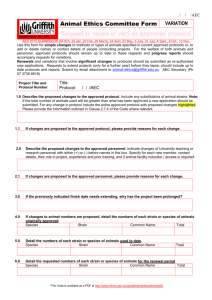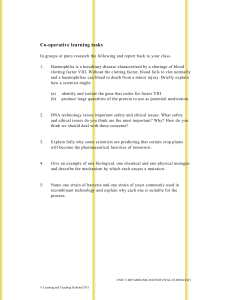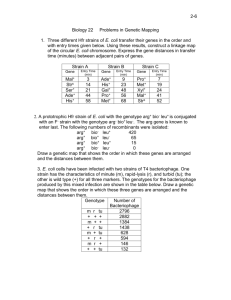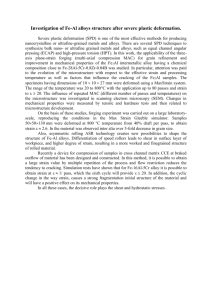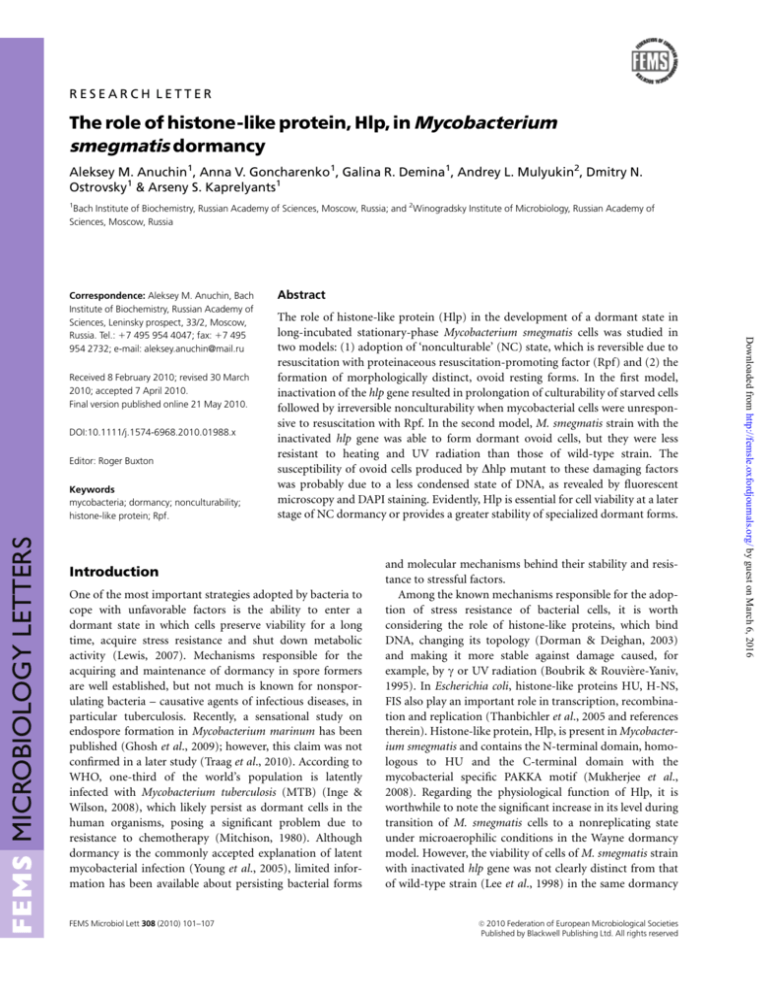
RESEARCH LETTER
The role of histone-like protein, Hlp, in Mycobacterium
smegmatis dormancy
Aleksey M. Anuchin1, Anna V. Goncharenko1, Galina R. Demina1, Andrey L. Mulyukin2, Dmitry N.
Ostrovsky1 & Arseny S. Kaprelyants1
1
Bach Institute of Biochemistry, Russian Academy of Sciences, Moscow, Russia; and 2Winogradsky Institute of Microbiology, Russian Academy of
Sciences, Moscow, Russia
Received 8 February 2010; revised 30 March
2010; accepted 7 April 2010.
Final version published online 21 May 2010.
DOI:10.1111/j.1574-6968.2010.01988.x
Editor: Roger Buxton
MICROBIOLOGY LETTERS
Keywords
mycobacteria; dormancy; nonculturability;
histone-like protein; Rpf.
Abstract
The role of histone-like protein (Hlp) in the development of a dormant state in
long-incubated stationary-phase Mycobacterium smegmatis cells was studied in
two models: (1) adoption of ‘nonculturable’ (NC) state, which is reversible due to
resuscitation with proteinaceous resuscitation-promoting factor (Rpf) and (2) the
formation of morphologically distinct, ovoid resting forms. In the first model,
inactivation of the hlp gene resulted in prolongation of culturability of starved cells
followed by irreversible nonculturability when mycobacterial cells were unresponsive to resuscitation with Rpf. In the second model, M. smegmatis strain with the
inactivated hlp gene was able to form dormant ovoid cells, but they were less
resistant to heating and UV radiation than those of wild-type strain. The
susceptibility of ovoid cells produced by Dhlp mutant to these damaging factors
was probably due to a less condensed state of DNA, as revealed by fluorescent
microscopy and DAPI staining. Evidently, Hlp is essential for cell viability at a later
stage of NC dormancy or provides a greater stability of specialized dormant forms.
Introduction
One of the most important strategies adopted by bacteria to
cope with unfavorable factors is the ability to enter a
dormant state in which cells preserve viability for a long
time, acquire stress resistance and shut down metabolic
activity (Lewis, 2007). Mechanisms responsible for the
acquiring and maintenance of dormancy in spore formers
are well established, but not much is known for nonsporulating bacteria – causative agents of infectious diseases, in
particular tuberculosis. Recently, a sensational study on
endospore formation in Mycobacterium marinum has been
published (Ghosh et al., 2009); however, this claim was not
confirmed in a later study (Traag et al., 2010). According to
WHO, one-third of the world’s population is latently
infected with Mycobacterium tuberculosis (MTB) (Inge &
Wilson, 2008), which likely persist as dormant cells in the
human organisms, posing a significant problem due to
resistance to chemotherapy (Mitchison, 1980). Although
dormancy is the commonly accepted explanation of latent
mycobacterial infection (Young et al., 2005), limited information has been available about persisting bacterial forms
FEMS Microbiol Lett 308 (2010) 101–107
and molecular mechanisms behind their stability and resistance to stressful factors.
Among the known mechanisms responsible for the adoption of stress resistance of bacterial cells, it is worth
considering the role of histone-like proteins, which bind
DNA, changing its topology (Dorman & Deighan, 2003)
and making it more stable against damage caused, for
example, by g or UV radiation (Boubrik & Rouvière-Yaniv,
1995). In Escherichia coli, histone-like proteins HU, H-NS,
FIS also play an important role in transcription, recombination and replication (Thanbichler et al., 2005 and references
therein). Histone-like protein, Hlp, is present in Mycobacterium smegmatis and contains the N-terminal domain, homologous to HU and the C-terminal domain with the
mycobacterial specific PAKKA motif (Mukherjee et al.,
2008). Regarding the physiological function of Hlp, it is
worthwhile to note the significant increase in its level during
transition of M. smegmatis cells to a nonreplicating state
under microaerophilic conditions in the Wayne dormancy
model. However, the viability of cells of M. smegmatis strain
with inactivated hlp gene was not clearly distinct from that
of wild-type strain (Lee et al., 1998) in the same dormancy
2010 Federation of European Microbiological Societies
Published by Blackwell Publishing Ltd. All rights reserved
c
Downloaded from http://femsle.oxfordjournals.org/ by guest on March 6, 2016
Correspondence: Aleksey M. Anuchin, Bach
Institute of Biochemistry, Russian Academy of
Sciences, Leninsky prospect, 33/2, Moscow,
Russia. Tel.: 17 495 954 4047; fax: 17 495
954 2732; e-mail: aleksey.anuchin@mail.ru
102
A.M. Anuchin et al.
model. We may reason that Hlp has no significant role in the
transition to dormancy in the relatively short-term Wayne
model but may be essential for developing dormancy in
nonreplicating cells at later stages. Indeed, many genes,
different from those expressed in cells undergoing starvation
in the Wayne model, are upregulated at late stages (4 24 h)
in M. tuberculosis cells subjected to hypoxia (enduring
response) (Rustad et al., 2008).
The objective of the present study is to clarify the role of
Hlp in dormancy in M. smegmatis cells obtained in two
experimental models after incubation in a prolonged stationary phase. We found that Hlp was essential for survival
of NC cells or for a greater stability of specialized dormant
forms, likely due to DNA condensation.
The purified PCR product was ligated into the pGEM-T
vector (Promega), resulting in pGEM-hlp, which was introduced into E. coli strain DH5a. Transformed clones were
selected and examined by PCR. Thereafter, pGEM-hlp and
pMind were digested with restriction enzymes BamHI and
PstI and the hlp fragment was ligated into the pMind vector.
The ligated product pMind-hlp was introduced into E. coli
strain DH5a, and the sequence of the cloned gene was
confirmed. All vectors were introduced into E. coli by
electroporation according to the BioRad protocol; to incorporate the vectors in M. smegmatis cells, we used the
procedure as described elsewhere (Parish & Stoker, 1998).
Materials and methods
A truncated form of Micrococcus luteus Rpf, named RpfSm,
served as an additive in resuscitation medium. RpfSm
contained the conserved Rpf domain followed by 20-aa
fragment of variable domain: ATVDTWDRLAECESNGTW
DINTGNGFYGGVQFTLSSWQAVGGEGYPHQASKAEQIK
RAEILQDLQGWGAWPLCSQKLGLTQADADAGDVDATE.
The truncated gene was amplified by PCR from the pET19b-Rpf (Mukamolova et al., 1998), using the T7 promoter
primer: GCGAAATTAATACGACTCACTAT and the reverse
primer: CGACGGATCCTCACTCGGTGGCGTCACGT (the
BamH1 restriction site is marked in bold). The purified PCR
product was digested with XbaI and BamH1, purified and
ligated into pET19b vector, which was introduced in E. coli
DH5a. The construct, containing the truncated rpf gene
(rpfSm), was sequenced and used to transform E. coli
HSM174 (DE3). RpfSm was purified from 350 mL cultures
of E. coli producer strain grown at 37 1C in the rich medium
(HiMedia) with ampicillin (100 mg mL1) to OD600 nm
0.65–0.8. After induction with 1 mM IPTG, growth was
continued for 2 h at room temperature. Cells were harvested
by centrifugation at 3000 g for 15 min and frozen in binding
buffer (BB) (20 mM Tris-HCl, pH 8.0; 0.5 M NaCl; 5 mM
imidazole). Thawed cell suspensions in 10 mM MgSO4
were treated with RNAse and DNAse at concentrations
Strains and plasmids used in this study are listed in Table 1.
Mycobacterium smegmatis strain MC2 155 was routinely
maintained on solid (1.5% agar) NB medium (HiMedia
Laboratories, India); only fresh 3–5-day-old colonies served
as inoculum to produce starter cultures. Cells were grown in
the standard Sauton medium or liquid NB (nutrient broth)
medium, as well as in the modified Hartman-de-Bont
medium (Shleeva et al., 2004) or modified SR-1 medium
(Anuchin et al., 2009) as described below. In standard CFU
assays, aliquots of decimally diluted cell suspensions were
plated on solid NB medium. The Dhlp strain and recombinant strains (Table 1) were maintained on the NB medium
with 10 mg mL1 kanamycin and grown under the same
conditions as the Wt strain.
Cloning procedures
The hlp gene was amplified by PCR using the forward
primer
5 0 -GTGGATCCTGGAAATCAGTGGTCACAG-3 0
and the reverse primer 5 0 -ATCTGCAGCCTCCCGACGAGA
AGTAACG-3 0 (BamHI and PstI restriction sites are in bold).
Table 1. Strains and plasmids used in the study
Dhlp
Dhlp-pMind
Dhlp-pAGH
Dhlp<rpf
Dhlp<rpf mut
Dhlp<hlp
pMind
pAGH
pAGR
pAGRmut
pMind-hlp
Kanamycin-resistant strain with inactivated hlp gene
Dhlp strain harboring the pMind plasmid
Dhlp strain harboring the pAGH plasmid
Dhlp strain harboring the pAGR plasmid carrying the rpf gene
Dhlp strain harboring the pAGR plasmid, carrying mutant rpf gene (Cys53 ! Lys, Cys114 ! Thr)
Dhlp strain harboring the plasmid carrying hlp gene
Kanamycin and hygromycin resistance
Kanamycin and hygromycin resistance
pAGH derivate carrying the rpf gene
pAGR carrying the mutant rpf gene (Cys53 ! Lys, Cys114 ! Thr)
pMind derivate carrying the hlp gene
2010 Federation of European Microbiological Societies
Published by Blackwell Publishing Ltd. All rights reserved
c
Lee et al. (1998)
This work
This work
This work
This work
This work
Blokpoel et al. (2005)
Mukamolova et al. (2002)
Shleeva et al. (2004)
Mukamolova et al. (2006)
This work
FEMS Microbiol Lett 308 (2010) 101–107
Downloaded from http://femsle.oxfordjournals.org/ by guest on March 6, 2016
Strains and growth conditions
Isolation and purification of recombinant
resuscitation-promoting factor (Rpf) protein
103
Histone-like protein in mycobacterial dormancy
10 mg mL1 each and then with 8 M urea. After sonication,
the crude extract was centrifuged at 6000 g for 30 min to
remove cell debris, and supernatant was applied onto a
2-mL Ni21-chelation column (Sigma) equilibrated with BB.
The Biological LP system (BioRad) was used for elution and
refolding of the protein on the Ni-column: first, a series of
washing steps with the BB, containing 8 M urea, were used.
The second, refolding step included washing with BB at
linearly decreasing urea concentrations (from 8 to 0 M). The
protein was eluted with a linear gradient of imidazole from
5 to 500 mM. Protein was collected at 0–250 mM imidazole
concentrations in a total volume of 4–5 mL. Rpf-containing
fractions (30–50 mg mL1) were dialyzed against 50 mM
citric acid–sodium citrate buffer (pH 6.0). Protein samples
were stored at 14 1C for 1 week without a significant loss in
its activity.
Myñobacterium smegmatis strains were grown under the
conditions that favored the entering wild-type strain to
‘nonculturable’ (NC) state (inability to produce colonies
on solid media) in stationary phase after cultivation of
mycobacteria in the modified Hartman-de-Bont medium,
lacking K1, at 37 1C for 120 h under aeration (Shleeva et al.,
2004). In the other model, the strains under study were
incubated for 4.5 months after growth in N-limited SR-1
medium to produce morphologically distinct ovoid cells
(Anuchin et al., 2009).
The ability of ‘NC’ cells to resuscitate in liquid medium
was estimated using the most probable number (MPN)
assays in triplicate repeats with inoculation of 0.1 mL cell
suspensions to 0.9 mL of the modified Sauton medium in
plastic 48-well microplates (Corning) as described previously (Downing et al., 2005). The Sauton medium that
served for resuscitation contained (L1): KH2PO4, 0.25 g;
MgSO4 7H2O, 0.25 g; L-asparagine, 2 g; glycerol, 6 mL;
ferric ammonium citrate, 0.025 g; sodium citrate, 1 g; 1%
ZnSO4, 0.05 mL; recombinant RpfSm protein, 5 mg
(pH 7.0).
Light and fluorescence microscopy
Cell suspensions were examined under a microscope Eclipse
E4000 (Nikon, Japan) in the phase-contrast and epifluorescence modes after staining with propidium iodide (3 mM) to
detect injured/dead cells or with 4 0 -6-diamidino-2-phenylindole (DAPI) (2 mg mL1) bound to double-helix DNA.
Excitation was at 510 and 330 nm, and emission was at
4 560 and 4 380 nm for propidium iodide and DAPI,
respectively.
FEMS Microbiol Lett 308 (2010) 101–107
One-milliliter aliquots were taken from stationary-phase
(48 h) cultures in NB medium or from cultures stored for
4.5 months in N-limited SR-1 medium and were transferred
into Petri dishes with 4 mL of liquid NB medium and then
subjected to UV irradiation (BUV-30 lamp, 254 nm) as
described elsewhere (Vorobjeva et al., 1995). Samples from
the same cultures were also heated at 60–80 1C for 10 min.
Cells after UV or heat treatment were plated onto solid NB
medium for CFU assays.
Results and discussion
As already demonstrated, after cultivation for 68–70 h in the
modified Hartman-de-Bont medium without K1 sources,
stationary-phase wild-type M. smegmatis cells entered a
dormant NC state and lost the ability to form colonies on
the nutrient agar. NC cells of the wild-type strain were
resuscitated in a liquid medium supplemented with Rpf.
Similarly, the isogenic strain (Wt<rpf) that harbors a
plasmid containing the M. luteus rpf gene, also adopted the
NC state, but resumed growth when transferred to the
appropriate liquid medium without added Rpf (Shleeva
et al., 2004). The previously designed approach to produce
and resuscitate NC cells was applied to study M. smegmatis
strain with inactivated hlp gene. Our experiments revealed
that M. smegmatis Dhlp strain and its derivatives developed
in the modified Hartman-de-Bont medium (without K1) at
similar growth rates compared with the wild-type strain
(data not shown). At the stationary phase, the Dhlp strain
entered the NC state (0 CFU) later than the Wt-pMind
strain with the empty plasmid (90–96 vs. 68–70 h) (Fig. 1a)
or wild type (not shown). Complemented strain Dhlp<hlp
harboring the hlp gene on the plasmid entered the NC state
only 2 h later than the Wt-pMind strain (data not shown).
Next, NC cells of Wt-pMind and Dhlp strains were tested for
their ability to resuscitate in the presence of recombinant
M. luteus RpfSm protein, which appeared to be more active
and stable during storage compared with full-length
M. luteus Rpf (unpublished data). Contrary to Wt-pMind,
NC cells of the strain Dhlp failed to resuscitate in the liquid
medium with RpfSm (Fig. 2). NC cells of the complemented
strain Dhlp<hlp were partially resuscitated by RpfSm
(Fig. 2). Therefore, the lack of Hlp resulted in transition of
mycobacterial cells to an irreversibly NC (or likely, moribund) state under chosen conditions (K1 depletion) but not
to a resuscitatable dormancy. Taken together, these data led
to the conclusion that Hlp does not affect the onset of the
transition to nonculturability but seems to be essential for
cell viability at a later stage of dormancy.
It was noteworthy that the strain Dhlp<rpf, lacking the
hlp gene and harboring the plasmid-carried rpf gene,
substantially differed from the Dhlp in culturability when
2010 Federation of European Microbiological Societies
Published by Blackwell Publishing Ltd. All rights reserved
c
Downloaded from http://femsle.oxfordjournals.org/ by guest on March 6, 2016
Formation and resuscitation of dormant
M. smegmatis cells
Heat and UV treatment
104
A.M. Anuchin et al.
109
106
108
107
106
MPN mL–1
Log10 bacterial count (CFU mL–1)
(a)
105
104
103
105
102
101
104
100
20
40
60
80
100
Time (h)
120
140
160
Wt-pMind
109
Δhlp::hlp
Fig. 2. Rpf-mediated resuscitation of Mycobacterium smegmatis NC
cells. NC cells of M. smegmatis Wt-pMind, Dhlp-pMind and complemented Dhlp<hlp strains were transferred to the liquid Sauton medium
supplemented (closed columns) with RpfSm (5 ng mL1) or without
(open columns) this protein. MPN assays were performed in triplicate by
serial dilution of cell suspensions in the above variants of the medium.
Average results of three independent experiments are shown; errors bars
represent SD. The CFU number in cultures before resuscitation varied
from 1 102 to 6.9 103 mL1.
108
107
106
105
104
103
102
101
100
20
40
60
80
100
Time (h)
120
140
160
Fig. 1. Transition to the NC state by Mycobacterium smegmatis strains
(as judged from CFU counting) in the modified Hartman-de-Bont
medium. m, Wt-pMind strain; ’, Dhlp-pMind [(a) experiment A]; ’,
Dhlp<rpf; , Wt<rpf; n, Dhlp<rpf mut [(b) experiment B). Experiments
A and B were repeated 11 times; results of a typical experiment are
shown. Each CFU point represents the average of five replicates. Error
bars designate SD.
cultivated in the modified Hartman-de-Bont medium. In
particular, Dhlp<rpf cells maintained the ability to produce
colonies even during a prolonged (180 h) stationary phase,
as opposed to Dhlp and Dhlp-AGH strains (Fig. 1b).
However, insertion of the rpf gene to wild-type M. smegmatis (Wt-AGR) caused the development of NC state of cells
incubated in the same medium and conditions (Fig. 1b), as
reported previously (Shleeva et al., 2004). To ensure that the
maintenance of plateability in long-stored Dhlp<rpf cultures was indeed due to Rpf production, we studied the
Dhlp<rpf mut strain (Table 1) with the rpf gene disrupted
by site-directed mutagenesis (Mukamolova et al., 2006).
Our experiments demonstrated that mutations in the rpf
gene restored the ability to adopt the NC state under the
given cultivation conditions (Fig. 1b). Thus, the combined
2010 Federation of European Microbiological Societies
Published by Blackwell Publishing Ltd. All rights reserved
c
Δhlp
action of a downshift of Hlp and an upshift of Rpf greatly
prolonged the ability of M. smegmatis to endure starvation
in a completely culturable state, revealing opposite effects of
two proteins on the formation of ‘nonculturability’. Earlier
we found that M. smegmatis culture in stationary phase
contained a proportion of viable cells which are capable of
cryptic growth (Shleeva et al., 2004). We speculate that Rpf
as a growth factor (Mukamolova et al., 1998) promotes
multiplication of a similar population of viable cells as
presented in a moribund Dhlp culture. This would result in
dynamic equilibrium between cell death and growth and
CFU, maintaining a stable level. Analogously, the delay in
transition to NC state by Wt<rpf strain, harboring the rpf
gene (Fig. 1b), may reflect the Rpf-mediated growth stimulation of some cells in the population. The significantly
different behavior of Dhlp<rpf and Dhlp strains may be
discussed from the point of view of the dual mode of Rpf
action: growth-supportive with respect to debilitating populations (as with Dhlp strain) or per se resuscitative to
nonplateable dormant cells produced by Wt or Dhlp<rpf
strains. Taken together, our results suggest that Hlp plays a
role in the adoption of reversible NC in M. smegmatis at
later stages of cultivation in the appropriate medium.
In the second set of experiments with Dhlp strain, we
used the approach previously developed to obtain morphologically distinct ovoid dormant cells of Wt M. smegmatis
after cultivation in the N-limited SR-1 medium. Ovoid
FEMS Microbiol Lett 308 (2010) 101–107
Downloaded from http://femsle.oxfordjournals.org/ by guest on March 6, 2016
Log10 bacterial count (CFU mL–1)
(b)
105
Histone-like protein in mycobacterial dormancy
Downloaded from http://femsle.oxfordjournals.org/ by guest on March 6, 2016
Fig. 3. Dormant ovoid cells of Mycobacterium
smegmatis Wt, Dhlp and complemented
Dhlp<hlp strains as viewed in phase-contrast and
epifluorescence microscopy after DAPI staining.
Samples from culture of ovoid cells obtained after
cultivation in modified SR-1 medium for 4.5
months of wild type (a, b), Dhlp (c, d) and
complemented Dhlp<hlp were stained with DAPI
(2 mg mL1) and visualized under phase contrast
(a, c, f) and fluorescent microscopy (b, d, e).
dormant cells survived for several months and possessed a
low metabolic activity level and elevated resistance to
heating and antibiotics. Long-stored cultures of these cells
contained a large proportion of NC cells that resumed
growth in liquid media (Anuchin et al., 2009). Growth rates
of Dhlp cells in the Sauton and modified SR-1 media were
the same as those of the Wt strain (data not shown). When
cultivated in SR-1 medium, Dhlp cells also produced ovoid
dormant forms, like the wild-type strain (Fig. 3). However,
ovoid forms of Dhlp strain were considerably less stable to
FEMS Microbiol Lett 308 (2010) 101–107
elevated temperature or UV exposure than were dormant
forms of Wt-pMind strain (Figs 4 and 5). Complemented
strain Dhlp<hlp revealed intermediate sensitivity to elevated temperature (Fig. 4). Similarly, Dhlp<hlp demonstrated partial restoration of stability to UV treatment
(1.3 0.75%, 0.2 0.097%, 0.02 0.014% of initial
CFU mL1 after 44, 97 and 146 J m2 irradiation dose,
respectively).
Hence, we may conclude that, despite the ability of
mycobacterium with inactivated hlp gene to produce ovoid
2010 Federation of European Microbiological Societies
Published by Blackwell Publishing Ltd. All rights reserved
c
106
102
100
101
10
Log10 bacterial count
(CFU mL–1) % of intial
Log10 viable cells count
(CFU mL–1), % of initial
(a)
A.M. Anuchin et al.
100
10–1
10–2
10–3
70
Temperature
80
1E-3
0
20
40
60
80
100
120
140
Exposure dose (J m–2)
100
10–1
10–2
10–3
10–4
10–5
10–6
60
70
Temperature
80
Fig. 4. Sensitivity of stationary-phase (a) and dormant ovoid (b) Mycobacterium smegmatis Wt, Dhlp<hlp and Dhlp strains to heating.
Suspensions of Wt-pMind (closed columns), complemented Dhlp<hlp
(cross-hatched columns) and Dhlp-pMind (open columns) were taken
from stationary (48-h cultivation) culture grown in standard NB medium
(a) and from culture of ovoid cells obtained after cultivation in modified
SR-1 medium for 4.5 months (b) and heated at 60–80 1C for 10 min.
These experiments were repeated three times; the representative results
are shown. Each point shows the average value of five replicates. The
error bars represent SD.
dormant cells, Hlp confers their resistance to stress conditions, consistent with published results as discussed below.
An extreme increase was shown in the Hlp level in
M. smegmatis cells subjected to cold shock (0 1C) and the
inability of the strain with the inactivated hlp gene to grow at
10 1C (Shires, 2001). As to the action mechanism, it is
possible that Hlp serves as a physical shield against stress
factors that impair DNA, as in the case of another histonelike protein, Lsr2, in M. tuberculosis, which protects DNA
from reactive oxygen intermediates (ROI) in vitro and
during macrophage infection (Colangeli et al., 2009).
Examinations of DAPI-stained ovoid cells under epifluorescence microscope revealed clearly distinguishable areas of
compact DNA in dormant ovoid Wt-pMind and Dhlp<hlp
cells, absent in Dhlp-pMind strain (Fig. 5). Evidently, Hlp
2010 Federation of European Microbiological Societies
Published by Blackwell Publishing Ltd. All rights reserved
caused changes in the nucleoid architecture in dormant M.
smegmatis cells, similar to the DNA condensation in E. coli
cells demonstrated to be the result of binding to Hlp
(Mukherjee et al., 2008).
Another histone-like protein, Hc1, is responsible for
nucleoid condensation in specialized dormant forms (reticular bodies) of chlamydia. A reverse process of DNA
decondensation due to Hc1 dissociation in chlamydial
dormant cells is controlled by the ispE gene product, an
enzyme of nonmevalonic pathway of isoprenoid synthesis
(Grieshaber et al., 2004, 2006). In this line, we have demonstrated self-reactivation of stationary-phase M. smegmatis
NC cells due to ispE hyperexpression (Goncharenko et al.,
2007).
Notwithstanding the significant increase of Hlp level in
M. smegmatis cells under hypoxia conditions in the Wayne
dormancy model inactivation of the hlp gene caused no
phenotypic changes, as judged from ability of Dhlp strain to
develop a nonreplicating state (Lee et al., 1998). In contrast
to models used in the present study, the Wayne model
reflects adaptation of cells to oxygen starvation when cells
remain fully culturable and do not produce morphologically
distinct dormant forms (Cunningham & Spreadbury, 1998).
The results obtained in our study, exemplified by
M. smegmatis, clearly show the significance of Hlp protein
for the formation and stress resistance of two types of deeply
dormant mycobacterial cells. Hlp (or other histone-like
proteins) may be engaged in mechanisms responsible for
prolonged persistence and stability of tubercle bacilli; however, further experiments are required to verify this possibility for MTB cells.
FEMS Microbiol Lett 308 (2010) 101–107
Downloaded from http://femsle.oxfordjournals.org/ by guest on March 6, 2016
Fig. 5. Sensitivity of Wt and Dhlp strains of Mycobacterium smegmatis
to UV irradiation. Suspensions of Wt-pMind and Dhlp-pMind cells were
taken from stationary (48-h cultivation) culture grown in standard NB
medium (&, Wt-pMind; , Dhlp-pMind strain) and from culture of ovoid
cells obtained after cultivation in modified SR-1 medium for 4.5-monthold culture (’, Wt-pMind; , Dhlp-pMind strain) and exposed to
different UV doses.
102
101
Log10 viable cells count
(CFU mL–1), % of initial
0.01
1E-5
60
c
0.1
1E-4
10–4
(b)
1
107
Histone-like protein in mycobacterial dormancy
Acknowledgements
We thank Brian Robertson for providing the pMind plasmid,
Thomas Dick for Dhlp strain and Galina Mukamolova for
pAGH, pAGR and pAGRmut plasmids. This work was
supported by the Programme ‘Molecular and Cellular Biology’
of the Russian Academy of Sciences and NM4TB EU project.
References
FEMS Microbiol Lett 308 (2010) 101–107
2010 Federation of European Microbiological Societies
Published by Blackwell Publishing Ltd. All rights reserved
c
Downloaded from http://femsle.oxfordjournals.org/ by guest on March 6, 2016
Anuchin AM, Mulyukin AL, Suzina NE, Duda VI, El-Registan GI
& Kaprelyants AS (2009) Dormant forms of Mycobacterium
smegmatis with distinct morphology. Microbiology 155:
1071–1079.
Blokpoel MC, Murphy HN, O’Toole R, Wiles S, Runn ES, Stewart
GR, Young DB & Robertson BD (2005) Tetracycline-inducible
gene regulation in mycobacteria. Nucleic Acids Res 33: e22.
Boubrik F & Rouvière-Yaniv J (1995) Increased sensitivity to ã
irradiation in bacteria lacking protein HU. P Natl Acad Sci
USA 92: 3958–3962.
Colangeli R, Haq A, Arcus VL et al. (2009) The multifunctional
histone-like protein Lsr2 protects mycobacteria against
reactive oxygen intermediates. P Natl Acad Sci USA 106:
4414–4418.
Cunningham AF & Spreadbury CL (1998) Mycobacterial
stationary phase induced by low oxygen tension: cell wall
thickening and localization of the 16-kilodalton alphacrystallin homolog. J Bacteriol 180: 801–808.
Dorman CJ & Deighan P (2003) Regulation of gene expression by
histone-like proteins in bacteria. Curr Opin Genet Dev 13:
179–184.
Downing KL, Mishenko VV, Shleeva MO, Young DI, Young M,
Kaprelyants AS, Apt AS & Mizarhi V (2005) Mutants of
Mycobacterium tuberculosis lacking three of the five rpf genes
are defective for growth in vivo and for resuscitation in vitro.
Infect Immun 73: 3038–3043.
Ghosh G, Larsson P, Singh B, Pettersson BM, Islam NM, Sarkar
SN, Dasgupta S & Kirsebom LA (2009) Sporulation in
mycobacteria. P Natl Acad Sci USA 106: 10781–10786.
Goncharenko AV, Ershov IV, Salina EG, Wiesner J, Vostroknutova
GN, Sandanov AA, Kapel’iants AS & Ostrovskiı̆ DN (2007)
The role of 2-C-methylerythritol-2,4-cyclopyrophosphate in
the resuscitation of the ‘nonculturable’ forms of
Mycobacterium smegmatis. Mikrobiologiia 76: 172–178.
Grieshaber NA, Fischer ER, Mead DJ, Dooley CA & Hackstadt T
(2004) Chlamydial histone–DNA interactions are disrupted by
a metabolite in the methylerythritol phosphate pathway of
isoprenoid biosynthesis. P Natl Acad Sci USA 101: 7451–7456.
Grieshaber NA, Sager JB, Dooley CA, Hayes SF & Hackstadt T
(2006) Regulation of the Chlamydia trachomatis histone H1like protein Hc2 is IspE dependent and IhtA independent. J
Bacteriol 188: 5289–5292.
Inge LD & Wilson JW (2008) Update on the treatment of
tuberculosis. Am Fam Physician 78: 457–465.
Lee BH, Murugasu-Oei B & Dick T (1998) Upregulation of a
histone-like protein in dormant Mycobacterium smegmatis.
Mol Gen Genet 260: 475–479.
Lewis K (2007) Persister cells, dormancy and infectious disease.
Nat Rev Microbiol 5: 48–56.
Mitchison DA (1980) Treatment of tuberculosis. J Roy Coll Phys
Lond 14: 91–95.
Mukamolova GV, Kaprelyants AS, Young DI, Young M & Kell DB
(1998) A bacterial cytokine. P Natl Acad Sci USA 95:
8916–8921.
Mukamolova GV, Turapov OA, Kazarian K, Telkov M,
Kaprelyants AS, Kell DB & Young M (2002) The rpf gene of
Micrococcus luteus encodes an essential secreted growth factor.
Mol Microbiol 46: 611–621.
Mukamolova GV, Murzin AG, Salina EG, Demina GR, Kell DB,
Kaprelyants AS & Young M (2006) Muralytic activity of
Micrococcus luteus Rpf and its relationship to physiological
activity in promoting bacterial growth and resuscitation. Mol
Microbiol 59: 84–98.
Mukherjee A, Bhattacharyya G & Grove A (2008) The C-terminal
domain of HU-related histone-like protein Hlp from
Mycobacterium smegmatis mediates DNA end-joining.
Biochemistry 47: 8744–8753.
Parish T & Stoker NG (1998) Electroporation of mycobacteria.
Methods Mol Biol 101: 129–144.
Rustad TR, Harrell MI, Liao R & Sherman DR (2008) The
enduring hypoxic response of Mycobacterium tuberculosis.
PLoS One 3: 502.
Shleeva M, Mukamolova GV, Young M, Williams HD &
Kaprelyants AS (2004) Formation of ‘non-culturable’ cells of
Mycobacterium smegmatis in stationary phase in response to
growth under suboptimal conditions and their Rpf-mediated
resuscitation. Microbiology 150: 1687–1697.
Shires K & Steyn L (2001) The cold-shock stress response in
Mycobacterium smegmatis induces the expression of a histonelike protein. Mol Microbiol 39: 994–1009.
Thanbichler M, Wang SC & Shapiro L (2005) The bacterial
nucleoid: a highly organized and dynamic structure. J Cell
Biochem 96: 506–521.
Traag BA, Driks A, Stragier P, Bitter W, Broussard G, Hatfull G,
Chu F, Adams KN, Ramakrishnan L & Losick R (2010) Do
mycobacteria produce endospores? P Natl Acad Sci USA 107:
878–881.
Vorobjeva LI, Khodjaev EY & Cherdinceva TA (1995)
Antimutagenic and reactivative activities of dairy
propionibacteria. Lait 75: 473–487.
Young M, Mukamolova GV & Kaprelyants AS (2005)
Mycobacterial dormancy and its relation to persistence.
Mycobacterium: Molecular Microbiology (T. Parish and
N. Stoker, eds), pp. 265–320. Horizon Bioscience, Norfolk.



